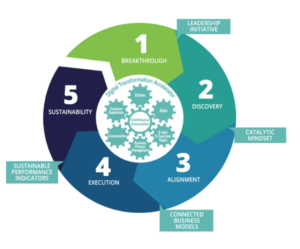Digital transformation is a requirement for success in the VUCA (Volatile, Uncertain, Complex, Ambiguous) world. 80+% of businesses (SMEs to multinationals from B2C to B2B) realize the strategic imperative of digital transformation. But, what happens when 7 out of 8 these businesses attempted Digital Transformation?

Disaster!
The simple fact is that 84% of companies fail at digital initiatives. And more shocking only 3% have implemented an enterprise-wide digital transformation.
BUT WHY?
Like sheep (known for following their brethren wherever…even to their death), companies are following each other in failure. Leadership teams observe a trend and react to the marketplace from the old patterns of behavior. They approach transformation from their area of comfort and past experiences.
But Surprise!
Digital Transformation is not just a new input in the competitive environment that they can adjust. Rather, it is a total shift in the business paradigm. Thus, it requires a holistic response to change – among leadership and their team, mindset and culture, innovation, operations and structure, business model, marketing strategies and performance criteria.
So where does this leave our frustrated executives and the many change agents faced with transformation to survive? They feel as if they are standing in front of the door that they are afraid to open! That is the reason why 84% of Digital Transformation projects failed.
How can YOU rise above the herd and not become a statistic in his alarming trend?
As a leadership team you must self-reflect. From the outset, we must recognize that going digital is not solely about technology. Here are eight changes necessary for success in the perilous process of Digital Transformation
Change 1: Get clear on your Intention
First, most companies are not transforming, instead they are only attempting to transform by wedging new mobile applications, engagement layers, or channels on old and brittle infrastructure. The Board and leadership team are not clear on their intentions and goals for digital transformation.
What is your focus?
- Iteration – doing the same things better with new technology and processes. OR
- Innovation -doing new things that create new value, thus changing all aspects of how and why companies operate.
Your intention must be continuous innovation; it is a necessity for digital transformation and an enabler for a greater purpose.
Change 2: Leaders morph into Catalyzers
Traditional leaders take responsibility, inspire and enable their team. In the VUCA world they must go beyond just directing operations to initiating and sustaining change. Catalyzers initiate, direct and increase the velocity of transformation while leveraging disruption. They challenge commonly entrenched assumptions about the fear of change and loss of control. For success, the leadership team must understand and make transformation a priority. They need to create a “digital vision” of total transformation that the Board, executives and operating team can buy into and a timetable that fits the company’s culture and goals and sustains the company during the transition. A big mistake companies make is treating digital transformation as a buzzword without enacting any policies or employing any backbone to their proposed transformation. If you want to avoid failure, digital transformation must become your proverbial North Star (focusing your direction) to guide you to where you want to be and to avoid taking unnecessary sidetracks. Your strategic transformation plan is critical, as it keeps you laser-focused on generating value at each stage of transformation.
Change 3: Digital transformation isn’t a technology thing
Most businesses address the challenge of Digital Transformation using the strategies they are most comfortable (e.g., investing in innovation). All industries are investing heavily in digital transformation technologies (hardware, software, and services), with 2018 expectations to be nearly $1.3 trillion worldwide, an increase of 17% over 2017. Most business “bought” their way into Digital Transformation by investing in digital technologies but were not prepared to make the internal changes within themselves or their organization. The VUCA world thrives on technology-driven change, but executives can’t control it. As Dion Hinchcliffe, Chief Strategy Officer, 7Summits said “while many are focusing primarily on the technology changes required for digital transformation, it’s also vital that we don’t neglect the people dimension of what is one of the greatest shifts in business in recent history.” Most businesses focus on the technology and not the people dimension.
Change 4: You can’t change your business, until you change yourself.
“Digital Transformation is about changing minds, attitudes, perceptions, and vision. That makes the most important skills and strategies centered on communication, education, and change management.” Kevin Jackson Director Cloud Solutions & Technology Engility Corp
The VUCA environment, by its very definition, challenges leadership teams to confront their values, beliefs and assumptions that have made them successful. The digital world, characterized by instant communication, global networks, information rich data and transformed customer decision process, compels them to change their approach to business decisions. It calls for new ways of listening to customers, employees and community. It requires re-thinking the core beliefs of a company and old sales strategies. It demands re-definition of risk, increased speed of innovation process, re-writing the rules of engagement and influence, re-design of outdated key performance indicators, and shifting focus from only profit to social impact and sustainability. That is a major adjustment for an agile Gen X leader but a mountain to climb for an entrenched and aging Baby Boomer. Furthermore, the digital revolution is just beginning, as artificial intelligence, cloud computing and digitization of operating systems and lifestyle become the new norm.
Change 5: Mindset change is critical but has a high risk
The above changes require a realignment of values and purpose leading to a Catalytic Mindset. It is an internal commitment to change the way we think and manage; it takes courage! It challenges business cultures that have “set-minds” to establish new internal supports to reinvent their mindset. This change has high risk because traditional executives don’t have experience in changing values or letting go of control. Also, these internal changes threaten long standing assumptions that supported their past actions and served as the foundation for relationships.
Catalytic Mindset combines four lenses of thinking (quantum, entrepreneurial, connective, data) to drive disruptions in the marketplace and catalyze life-changing innovations and social impact. It frames the organizational culture and sustains the change. Everyone from the CEO to the intern must buy into this new mindset as resistance and fixed approaches easily stymie transformation. The entire team must be open, communicative, and adaptable. The resulting agile culture will shake–up the “set-mind” and usher your enterprise into to a new level of openness, innovation and productivity.
Change 6: Really love your customer and the data generated
Most studies on Digital Transformation highlight the critical importance of paying attention and responding quickly to customer experiences. It is labelled “Customer First” and “Customer is King,” But it is empathy that underlies true success with the connected consumer. It translates to obsessively listening to his/her words, feelings, values, and actions that generate data points on the needs and interests of a voter, patient, consumer or client. The objective is to personalize the message, build a loving relationship and offer a user -attractive product to make it easier to commit to, adopt or buy. At the root of maximizing the customer experience is data; it generates analytics and insights to see what works, what your customers wants and how you can deliver it. Data requires performance metrics to drive decision-making.
Change 7: Deficient skills inhibit change
Digital skills are often cited as obstacles to executing a digital strategy. Cultivating a team that integrates both the mindset and analytical skills are essential for successful digital transformation. Digital strategies are plentiful but not enough; you need a team that is competent with the technology and has the skills to integrate it into your organization to implement the strategy. Talent acquisition is the key to being competitive.
You need to augment the talent of your employees, but not bog them down with every single new application. As Forbes reports, organizations commonly use 1,020 applications across the business yet on average only about 29% of the applications are integrated. This trend has overwhelmed tech executives deterring digital transformation and racking up about 22% of annual IT budgets just on integration. Let your talent use their skills productively with clear and obtainable expectations and goals.
Change 8: It takes patience
Digital transformation is like a multifaceted diamond. Each facet reflects a different solution that fits the business objectives, marketplace dynamics and the transformation timetable of your company.
Transformation can be initiated Externally— imposed on a company by environment and competition or Internally— by a committed leadership team. It can be step-by-step (less risky) or comprehensive. Business leaders must evaluate their patience or need for immediate results. Here are six responses. Which one is right for you?
Step-by-Step Digital Transformation
Step-by-step Digital Transformation targets one element of the transformation process, the business model (related strategies and operations). Here are three less risky strategies.
- Strategic Disruptive Boot Camp–focuses your team on “owning” (instead of resisting) the disruptive forces in the environment. It generates new business models and replaces “business as usual” thinking. Your team experiences an innovative strategic exercise to turn their insights back-on the competitor and drive a radically new business model for your company.
- Purposeful Design Thinking–is the compass that gets us from where we are to where we want to be. It is a human-centered design that empowers you to connect with your mission, your audience, and measure your progress keeping your eye on the destination. The result is a Transformative Management.
- Empathetic Insights Methodologies– calls for obsessively collecting and interpreting data to generate new insights and then translate those into strategy and action points. While all of these require evaluation and adaptability, this strategy uses data to drive transformation.
Comprehensive Digital Transformation
In contrast, Comprehensive Digital Transformation targets the organization. Driven by a committed leadership team, these strategies focus on organizational change and adaptability. Here are three approaches.
- Rapid Innovation Engine – The Rapid Innovation Engine is the first step toward Comprehensive Digital Transformation. This engine serves as the company-wide hub for innovation and transformation. Multi-functional and inter-generational by design it initiates and sustains continuous innovation. The Innovation Engine sits outside the formal organizational structure and reports directly to the Board or CEO.
- Exponential Transformation– This high velocity (3-6-months) transformation is initiated after the Catalytic Mindset has been adopted. The team jumps into the digital world building a new business model and iterating with constant experimentation, evaluation and adaptation. It uses the 3D printer as a methapor for the process of change and innovation.
- Integrated Digital Transformation– This six-step process (12-24+ months) is total transformation from an OldCo to NewCo. It addresses your leadership goals with a focus on breakthrough, discovery, alignment
 (mindset and culture), strategic innovation, execution, and sustainable evaluation. It designs a new business model that generates sustainable outsets for all stakeholders.
(mindset and culture), strategic innovation, execution, and sustainable evaluation. It designs a new business model that generates sustainable outsets for all stakeholders.
Implementing one of these models, you can successfully rise above the herd. Be smart and intentional; develop the mindset, tools, and resources to succeed where others have failed.
Sign Up for a Breakthrough Workshop for your Business Today!
Ira Kaufman, Digital Transformation Strategist, CEO, Social Entrepreneur and Educator. His company, Entwine Digital, works with midsize and multinationals to design values-based Digital Marketing and Transformation strategies and trains World Class Digital Leaders. His Transformative Management platform provides a values-driven framework for managing continuous change to fuel purposeful impact. He is co-author of Strategic Harmony… 21 Solutions to the Shattered World ( 2018)
Will Tharp, Content Development Associate, Entwine Digital Junior, Lynchburg College.






Leave A Comment